|
Chapter
III The Pagan Period:
Burma's Classic Age - 11th To
14th Centuries
Part 4
D. SCULPTURE
1. General
Introduction
The buildings
still standing at Pagan are impressive, not only in their numbers but also
in their architectural techniques, size, decoration, and creative floor
plans. This leads logically to an expectation that there would also be a
vast number of extant images since each temple would have had at least one
major cult image and no doubt several secondary images. Surely, there
would have been also an abundance of small images for personal use in
household shrines during a prosperous period of more than two hundred years.
Alas, that is not the case. Other than images that have remained within
the temples, there are relatively
few images extant from the Pagan Period numbering in the hundreds rather
than the thousands.
This situation is
explained in part by the fact that the major image(s) in most temples were
made of brick and stucco and, over time, all of these images were gutted
by vandals while seeking the contents of the small deposit boxes that were
placed behind the neck and navel. If this explanation accounts for the
brick and stucco images, why then are there so few images of stone or
metal? (Sandstone was primarily used for secondary images placed in temple
niches for only a short period during the late11th & early 12th
centuries and was then abandoned.) Why there are so few metal images
remains a mystery.
2.
A Thematic Discussion of Iconography and Meaning
a. The Enlightened Buddha
One of the
peculiarities of Buddhist sculpture is that the most important event in
the Buddha’s life from the point of view of mankind is not the event most
frequently represented in sculpture. Depiction of the Buddha's personal
enlightenment vastly outnumber representations of all other events in his
life including that of his first sermon in which he shared his recently
discovered knowledge with all humankind. The multiple images of the Buddha
in Burmese art are excellent examples of this peculiarity in which the
Buddha is most frequently shown seated with legs folded; left hand in his
lap, palm upward; right hand on his shin, palm inward with fingers
pointing toward the earth (bhumisparsa mudra). This hand gesture is
symbolic of his overcoming the last obstacle to enlightenment, self-doubt.
After years of asceticism and many days’ meditation under the Bodhi
tree, the Buddha began to doubt that his past lives had been sufficiently
perfect to warrant attaining enlightenment. This was because he believed
in rebirth - a belief that the soul, like energy, cannot be created or
destroyed, but instead experiences changes only from one form to another.
Therefore, the Buddha, like all mankind, had innumerable past lives, all
of which would have had to have been lived to perfection if the Buddha was
to achieve Nirvana. His difficulty lay in the fact that, like other
mortals, he could not remember all his actions in all his former lives.
Therefore, he could not be absolutely sure that enlightenment was eminent.
By placing his hand on his shin and pointing towards the earth, he
summoned the Earth Goddess to come to his assistance. Since in his former
lives, the Buddha had participated in the common practice of pouring water
on the ground to witness each of his meritorious acts, the Earth Goddess
was able to wring a "tidal wave" of water from her hair that had
accumulated over the Buddha's many previous lifetimes which was proof of
his steadfastness and perfection. The Earth Goddess (Vasundari -
Pali or Wathundaye - Burmese) is presented as a woman wringing
water from the tresses of her hair, which constitutes one of the rare
instances where women played an important role in the Buddha's life.
This role, however, was not trivial. It was of pivotal importance because without
her witness and assistance the Buddha would not have gained enlightenment.
|
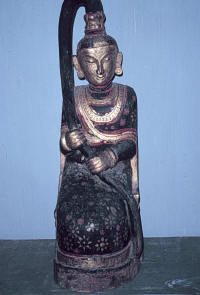
The Earth Goddess wringing water from her hair |
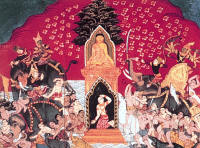
The Earth Goddess below the Buddha's Throne (manuscript
illustration) |
Since the Buddha's
complete enlightenment occurred immediately after "Calling the Earth
Goddess to Witness" and since enlightenment takes place within the body
without necessarily any outward indication, the iconographic position of
"Calling the Earth to Witness" has come to be accepted as representing the
enlightenment of the Buddha. To enhance this association, the cranial
protuberance (usnisha = cosmic consciousness or supramundane
wisdom) and the enigmatic "smile of enlightenment" were also employed.
Images of The
Buddha seated in bhumisparsa mudra have been endlessly replicated
in the art of Burma and Southeast Asia because it is a reminder to all
mankind that there is a way to end human suffering. Therefore, as such,
the creation of every additional image of the Buddha is a meritorious act
that improves the donor's karma. The multiple images of this event
stamped on clay votive plaques evidence the zeal of ancient donors who
at times created forty or even one hundred images of the Buddha with a single impression of a metal
mould. Because of the large number of Buddha images, these plaques were
thought to be especially efficacious in assuring the ritual purity and
power of a specific site and, therefore, were often placed in underground
chambers below the center-most point of the sanctum in a Buddhist
building.
b. The Buddha’s Two Disciples
In Burma, two
devotees frequently appear at either side of the Buddha's throne and are
identified by the Burmese as his two chief disciples, Mogallana and
Sariputta, although their presence at enlightenment is not
historically (i.e., canonically) correct. At the time of enlightenment,
all the Buddha's friends had abandoned him and it was not until later that
disciples came to learn his newly discovered knowledge. The insistence of
the Burmese to place these two figures at the feet of the Buddha, from at
least the 11th century onward, may be explained in part by the Burmese
belief that Buddhism was introduced into Burma during the Buddha's
lifetime by two of his disciples. This serves to strengthen Burmese ties
to the purest version of the Buddha's message – a particular concern of
the Theravada Buddhists - which is considered to have been pure and
without corruption during his lifetime - although none of the several
names given to the early Buddhist missionaries to Burma is Mogallana
or Sariputta.
c. Buddhist Monks and Their Belongings
Most Burmese
males are expected to join the monkhood at some time during their lives,
if only for a brief time. Boys, usually between ages 8 and 13, enter a
monastery as a novice after their ceremonial induction or Shinbyu.
The entire community is invited to this ceremony, which re-enacts the
various stages in the Buddha's life up until the "The Great Renunciation"
when the Buddha adopted the restricted regimen of an ascetic (=monk).
Ordained Buddhist monks are invited to perform the induction ceremony for
a novice and receive gifts of the few necessities allowed them by
canonical law. The rules and regulations under which the novice and the
monks must live are contained in the Tripitika, excerpts from which
are recorded within the Kamawasa, an especially ornate form of
Burmese Buddhist manuscript that is produced for use during a Shin Byu
ceremony. A new Kamawasa is presented by each novice and is then used to
instruct the fledgling novice how to read aloud the Pali language of the
Tripitika text, which is a required part of the induction ceremony.
The manuscript is then donated to the monastery by the novitiate and his
family.
Buddhist monks, as
part of their vows, renounce the things of this world including all
personal property. The monastery loans each monk their few personal
belongings that often vary according to sect and country. In Burma the
permitted items are an alms bowl with cover and carrier; three cotton
robes (untailored, simple rectangles of cloth), a belt, sandals, a fan, a staff, a
rosary, a razor, and a drinking cup. Two sheets, Towels, toothbrush,
toothpaste, and simple herbal medicines are also allowed. A monk may
travel and carry all these items on his person. This can be seen in
sculptures such as those of the Burmese monk, Shin Thiwali, who is the
Burmese patron saint of travel. His image within the home is also thought
to prevent domestic fires and theft.
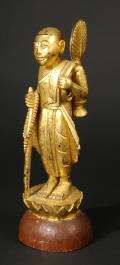
Wooden gilded image of Burmese monk Shin Thawali, 19th
century
Burma Collection, NIU Art Museum |
In Burma an
acceptable, but non-canonical, item a monk may possess is a betel nut
canister, because the chewing of betel is considered to be medicinal and
health promoting and monks are allowed a few, select herbal remedies.
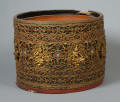
Lacquer ware
betel nut canister, 20th century
Burma Collection, NIU Art Museum |
Monks spend all of
their time in religious pursuits and therefore do not work at mundane
tasks. They exist entirely on the donations of the laity and leave the
monastery each morning at dawn to collect donated food in their alms
bowls. Since the laity views these donations as a means to make merit to
improve their own karma, on ceremonial occasions monks are invited to
ritually receive large amounts of food. Large, ornate alms bowls are
used for this ritual presentation of food by the laity to the monks.
When worn out, all
items are returned to the head monk for disposal and discarded monk's
robes may be used as the foundation from which to make the pages of a
Kamawasa manuscript.
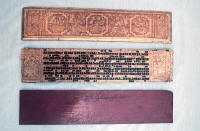
Kamawasa manuscript: top to bottom – outer face of wooden front cover,
leaf painted on lacquered cloth, lacquered back cover
|
d. Religious Manuscripts and Books
Ancient Buddhist
books were written in the Buddhist language, Pali, (or possibly
Sanskrit) on specially prepared fronds that had been picked from the
talipot palm. This produced nearly illegible engraved lines that were then
made distinct by rubbing each engraved leaf with soot and oil. The leaves
were then arranged on a short wooden rod or peg that passed through a
small hole in each page. The bundle of pages was then placed between two
wooden covers, often bound with a cord, and inserted in a cloth envelope.
The long, rectangular shape of the palm leaves determined the shape of a
Buddhist book whose proportions are inverse to those of western books:
Buddhist books are much broader than tall, whereas western books are
usually more tall than broad. The format of a manuscript made of palm
leaves was retained when the Kamawasa was created by the Burmese
from cloth, lacquer, and gold leaf.
The Shan peoples
in northeast Burma created religious books from a paper made from the
cambium of the mulberry shrub. Although made of paper that is concertina
folded, the form of these books conforms to that of a stout palm leaf
manuscript. Each accordion folded page is read in succession on one side
of the single sheet and then the book is inverted in order to read the
succession of folds on the opposite side.

Parabeik,
concertina folded manuscript
Burma Collection, NIU Art Museum |
All types of books
when not being used were kept in wooden chests to prevent damage from
insects, mold, humidity, and light and consequently were among the most
valued objects within a monastery.

Manuscript Chest or Sadaik
Burma Collection, NIU Art Museum
(Large
picture is highly detailed
and may be slow to load) |
e.
Creatures of the Himavanta Forest
In Buddhist
cosmology, the thirty-three most powerful gods of Hinduism and Buddhism
live on the highest peak of Mt. Meru. Mythical creatures inhabit the
Himavanta Forest that grows on the lower slopes of Mount Meru. When these
powerful beings enter the world of man, they are usually benevolent, if
treated properly. These creatures include the Chinthe, a leonine
creature with flaming mane and body, who is a guardian of Buddhism, and
today is the national symbol of Burma. Chinthes are ubiquitous in
Burmese art and often appear in pairs as guardians on either side of the
entrance to a Buddhist temple or stupa.
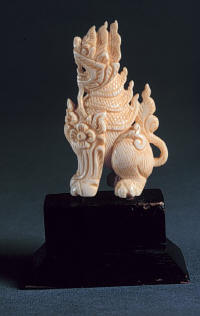
Chinthe
carved in ivory, 20th - century
Burma Collection, NIU Art Museum
The Manukthiha
is a uniquely Burmese creation that consists of the bodies of two lions
with a single head. Often, in late examples, the torso and head is that of
a human, not a lion
Slide: Manukthiha
from Shwedagon Stupa, 20th century
- to be added Spring 2003
Another composite
creature type that combines human with avian characteristics is the
Kinnara (male) or Kinnari (female) who appear frequently in
adoring pairs and are considered the "love birds" of the Himavanta Forest.
It is these creatures that are used to adorn the walls of temples as well
as the pulleys that are attached to Burmese looms, which are frequently
operated by unmarried girls whose thoughts, when not on weaving, often
turn to thoughts of love and their future family. Excellence in weaving
is considered a desirable characteristic to attract a husband.
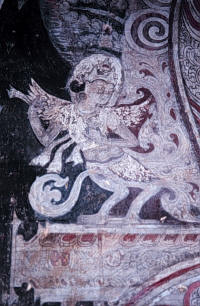
Wall
painting of a Kinnari, Pagan, 13th century |
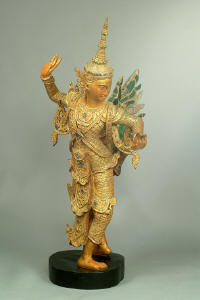
Image of a Kinnari, 19th century
Burma Collection, NIU Art Museum |
An inhabitant of
the forest with a normal anatomy is the Hamsa (Hintha - Pali)
or brahmani duck, which symbolizes marital fidelity, since this species
has a single mate for life. Hamsas hold a branch of fructifying
foliage in their beak as a symbol of prosperity and fertility .
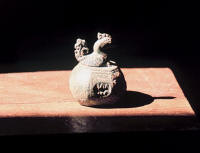
Bronze Hamsa market weight
3.
Examples of Buddhist Sculpture
a. Stone and Metal Images
Stone and metal
images in Burma most often depict the Buddha
seated with legs crossed on a
stylized lotus throne with both soles of the feet visible (= padmasana).
The right hand, palm inward, points downward across the middle shin and
the left hand, palm upward, rests in the lap (bhumisparsa mudra).
Depictions of the Buddha in this position first begin to predominate
during the Pagan Period, a trend that has continued to the present day.
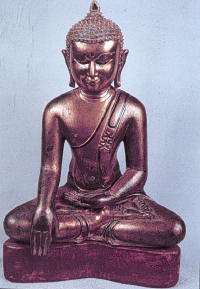
Bronze image of the Buddha, Early Pagan Period |
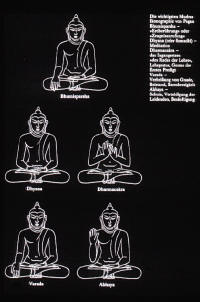
The five most common hand gestures (mudras) employed in sculpture of Gautama
Buddha |
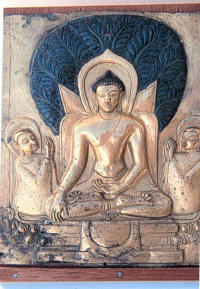
Gold repouse plaque with seated Buddha and two disciples
Early Pagan Period |

Standing sandstone image of Buddha with hands in dharmachakra mudra, Kyauk ku Umin
temple
Early Pagan Period |
There are,
however, a few images that show the Buddha in other body positions - as
dictated by the event being depicted - such a standing, walking or lying
down. These body positions are most frequently used when depicting the
Eight Great Events of the Buddha’s life or the events of the Seven Weeks
after Enlightenment, in which there was a particular interest during the
Pagan Period.
The convention
used at Pagan to indicate walking is of interest because it does not show
the body or feet in motion (as later, in Thai art). Instead, body movement
is shown by having the Buddha’s robe swing asymmetrically to one side or
by placing one of the Buddha’s feet at a slightly higher elevation than
the other.
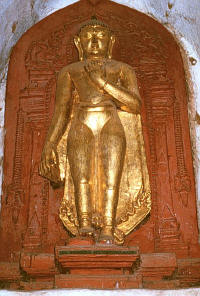
Walking
Buddha – asymmetrical robe, Ananda Temple
There are at least two styles of sculpture that date to the Pagan
Period.
One style best
evidenced by the early stone images found in Mon temples is derived from
the Pala style of Bihar and Bengal of the 8th to 10thcenturies.
This style juxtaposes the bold, smoothly modeled forms of the human body
against precisely detailed ornamentation – often of a throne backing. The
body is full and plump without any indication of the muscle groupings or
bones within the body. The shoulders are broad and round while tapering to
a relatively narrow waist. In standing images the thighs appear as
effeminately full and round, a visual expression of the canonical dictate
that the Buddha should have thighs that resemble the buds of a lotus
flower. The head has sharply defined features and may be triangular to
oval with a pointed chin and flat cranium. The hair is represented by
small, snail shell curls. The cranial protuberance or usnisha , sits well
back on the head, is relatively small and may terminate in a small
flame-like finial. The eyes are half closed and look downward (rather
than directly at the worshiper, as is frequently the case with Buddha
images in Thailand). The long, aquiline nose is almost continuous with the
broadly arched eyebrows. The mouth is small and pursed, with the upper
lip often slightly protruding. The ears are long, do not touch the
shoulders, and appear concave when viewed frontally. The neck is of normal
length and often has three semi-circular lines or wrinkles considered to
be beauty marks. The fingers are of normal length. The monastic robes,
consisting of two parts, clings to the body and is almost invisible except
for the hems that are lightly incised across the chest and are more boldly
indicated around the wrists and shins. A third robe, folded into a
rectangle and draped across the shoulder terminates, in fish tail folds.
This Pala style image is generally replaced by the middle of the Pagan
Period by a Burmese Style of image, and is revived in later periods only
when there is a conscious desire to imitate the classic age of Pagan.
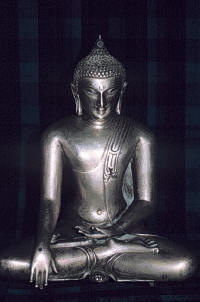
Bronze image of the Buddha, Pagan Period |
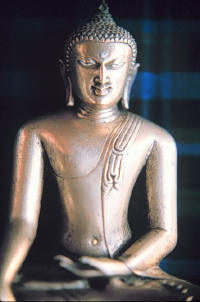
Bronze image of the Buddha, detail, Pagan Period |
The second style is evidenced at Pagan by number of seated Buddha
images that typically have a more corpulent body, a head that is tilted
forward with a short-to-non-existent neck, long earlobes that may touch
the shoulders, and fingers of uniform length. This style becomes part of
the mainstream of Burmese art and examples frequently occur during later
periods.
Among
the objects unearthed among the temples at Pagan are three elegant bronze
lotus buds held upright on elaborately decorative stems. The eight petals
of each open outward to reveal a seated Buddha, a stupa or a shikhakra
temple at its center. On the inside of each petal is depicted one of the
Eight Great Events in Buddha's life. Similar lotuses have been found in
Nepal and Tibet and all were probably used ritually on a temple altar.
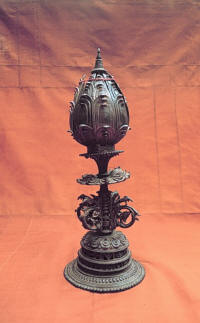
Bronze Lotus Bud, closed position |
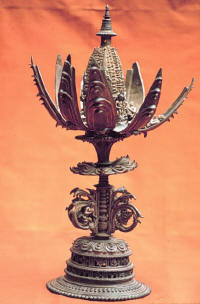
Bronze Lotus Bud, open position |
The finest caving
that has survived from the Pagan Period is found on a series of over
forty-seven miniature stone plaques that are carved from a fine-grained
steatite (andagu – Burmese). These carvings most often represent the
Eight Great Events of the Buddha’s life with the Enlightenment being
placed in the center. A particularly Burmese sub-set of these plaques
includes in an inner band of small images representing the events of the
Seven Weeks after Enlightenment. At times, the central Buddha image is
shown wearing a crown.
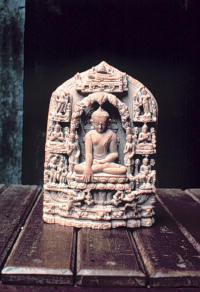
Stone plaque with Eight Great Events |
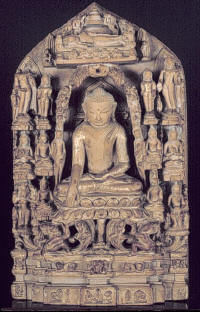
Stone plaque showing Eight Great Events in outer arc of figures and
Seven Weeks after Enlightenment on either side of the central image. |
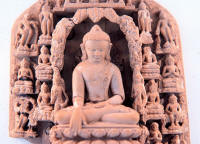
Detail from stone plaque showing Eight Great Events in outer arcof
figures and Seven Weeks after Enlightenment on either side of major image. |
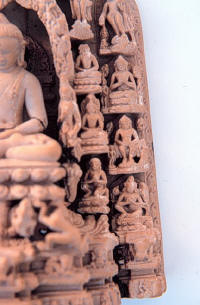
Detail from stone plaque showing Eight Great Events along outter
edge and Seven weeks adjacent to central image. |
b. Wood Sculpture
A wooden image
depicting the Buddha’s decent from Tavatimsa Heaven, where he had gone to
preach the Four Noble Truths to his mother, is remarkable for a number of
reasons: the subject is not often presented as an independent image, it
is one of the few wooden sculptures to have survived until today, and it is
well composed and sensitively modeled.
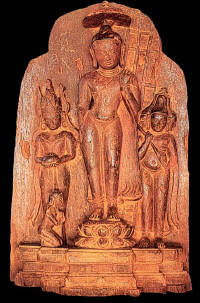
Woodcarving of the Buddha’s Descent from Tavatimsa Heaven |
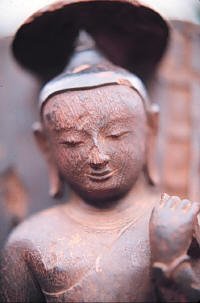
Detail, Head of Buddha from Descent from Tavatimsa Heaven |
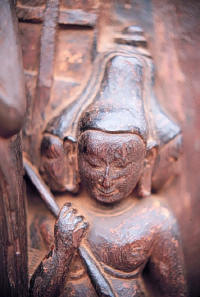
Detail, Head of Brahma from Descent from Tavatimsa Heaven |
Unusually, The
Buddha is shown standing in the elegant thrice-bent stance of tribhanga.
Sections of the jeweled tripartite ladder can be seen above his shoulder
and behind his feet. The two Hindu gods that accompany him are: Brahma
with three of his four heads visible holding an umbrella over the Buddha’s
head while Vishnu carries the Buddha’s alms bowl. The small figure seen
kneeling at the Buddha’s feet may represent King Udayana who, according to
some versions of The Descent, had a sandalwood likeness of the Buddha
created when he left this world for Tavatimsa Heaven. King Udayana
brought the image with him when he came to receive the Buddha at his
descent, an indication that the Buddha had not been forgotten during his
absence. If this account is true, King Udayana would have been responsible
for creating the first image of the Buddha. (Images of the Buddha were not
produced in abundance until the 1st century AD.)
Unfortunately, the hands and anything they may have held is now missing
from this sculpture.
c. Votive
Tablets
The most numerous
and, perhaps, the most intimate objects from the Pagan period are the clay
votive tablets that were stamped out and signed by many kings and nobles.
The creation of these tablets, each displaying at least one image of the
Buddha and some including over 100 images, was thought to produce good
merit for its maker. The incentive for their creation is not in doubt,
like so much concerning the Pagan Period, because many donors wrote and
signed their intentions on the back of the tablet. King Anawratha’s
tablets state that “This Buddha was made, with his own hands, by Sri
Maharaja Aniruddhadeva, with the object of emancipation [i.e. gaining
Nirvanna]”. Anawratha’s
tablets had his tablets inserted into religious foundations throughout his
kingdom.
The face of the
tablet often displays a Buddha in bhumisparsa mudra seated within a
temple that is similar to the one constructed at Bodhgaya, India, where
the Buddha achieved enlightenment. Two lines of Sanskrit in North Indian
characters of the 10th to 11th centuries is often
imprinted below the Buddha images. This is a statement of the Buddhist
creed in its most compressed and basic form: “The Buddha hath the causes
told, Of all things springing from causes, And also how things cease to
be, Tis this the Mighty Monk proclaims”.
Although the use of votive tablets at Pagan continued a tradition that
originated in India and some tablets found in the two countries are
identical, it is clear that votive plaques were created at Pagan because
bronze and clay molds have been discovered there. Also, the Pagan donors
signed many of the plaques in script.
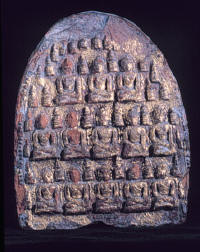
13 Buddha Image Votive Tablet, 11th c. Pagan |
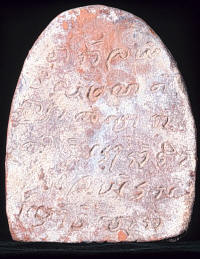
11 13 Buddha Image Votive Tablet
Verso writing states
tablet made by King Anawratha’s
wife,
Oueen Chipe
|
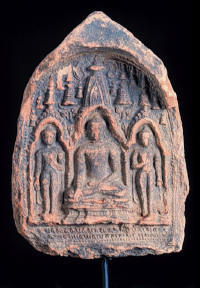
Tablet from Taugaung with seated Buddha flanked by two standing Buddhas |
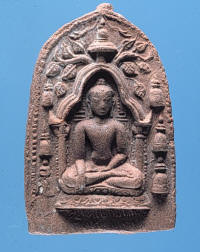
Seated Buddha in Mahabodhi like shrine with Bodhi tree |
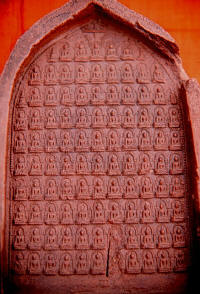
13th
century plaque with 100 miniature Buddha images |
|
5. Painting
a. Wall
Paintings
The interior
decoration of Pagan temples consisted almost entirely of wall paintings
that covered the ceiling vaults as well as all of the interior walls.
Painted designs were fitted into a framework of architectural moldings
that could be executed three-dimensionally in stucco or two-dimensionally
in trompe l’oeil painting. More than 387 Pagan Period temples
preserve some trace of their once colorful interiors.
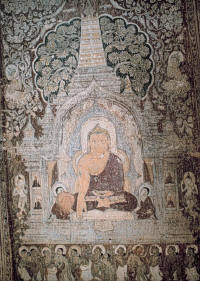
Wall painting of Buddha under Bodhi tree with disciples |
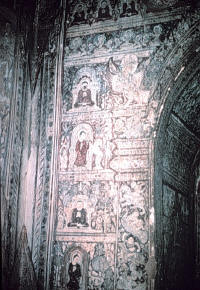
Wall paintings surrounding door opening |
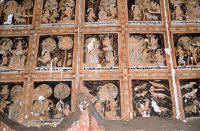
Wall painting of Jataka TalesKubyauk
gyi, Wetkyi-in |
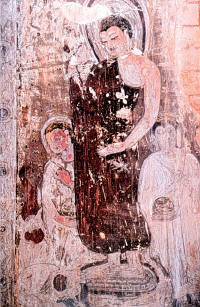
Wall Painting of Standing Buddha with disciples |
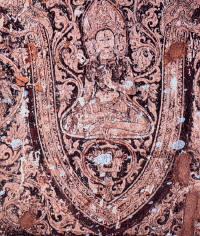
Frieze of deity and vegetation |

Wall Painting of Hamsas |
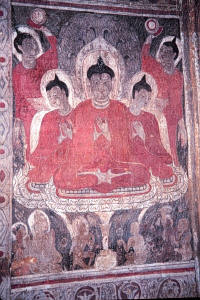
Wall Painting of Miracle of Double Appearances |
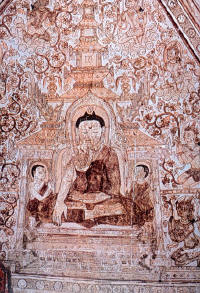
Wall Painting of Buddha flanked by disciples |
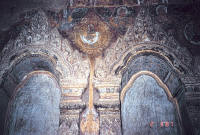
Painting of niche moldings and wall |
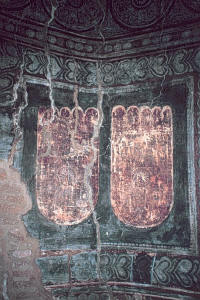
Painting on ceiling of Buddha’s footprints |
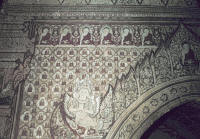
Wall painting around door includes Buddhas, Kinari and animals
Payathonzu Temple |
|
The walls were
first prepared with several coatings of fine mud or stucco that were let
thoroughly dry before receiving the multi-colored hues produced from
natural colorants. Scenes were created from preliminary drawings whereas
stencils were probably used for motifs that were repeated.
The program of
paintings within a temple usually included a Bodhi tree realistically
painted above the brick and stucco image of the Buddha that served to
frame and emphasize this central feature. On the wall on either side of
the three-dimensional Buddha image were painted images of the Buddha’s
attendants and disciples, often Mogallana and Sariputta. A frieze
encircling the remaining three walls of the major shrine might be composed
of large tear-shaped Bodhi leaves or kirtthimukha masks. Below this often
appear images of the Twenty-eight Buddhas of the Past, while lower down
are painted scenes of the Buddhas life, usually the Eight Great Events.
Elsewhere within the temple, often on the walls of the entrance hall,
appear small squares each representing one of the 550 former lives of the
Buddha referred to as Jataka Tales. Below each square the chapter number
and name of each Jataka was written in Mon or Old Burmese so that each
scene is easily identified. The decorative programs in a few temples
include scenes from the history of Buddhism, the Buddha’s footprints and
horoscope, or a Buddhist cosmological map. The ceiling vaults were most
often covered with small, identical, endlessly repeated motifs of small
seated Buddhas, a motif known as The Thousand Buddhas.
b. Paintings on
Cloth
Paintings on cloth
from the Pagan Period were unknown until in 1984 when a fragment was found
wrapped around the arm of a stucco figure in temple number 315.
Eventually, with expert restoration, some 30 fragments have been
identified as belonging to the same painting that depicts a Jataka tale in
long horizontal registers that include captions. The style of painting is
exactly the same as the wall paintings found in the Lokateikpan and the
Myinkaba-Kubyaukgyi and therefore can be dated to around 1113 AD. Thus,
this is the earliest known narrative scroll in the Pala style in
existence. All Pala style paintings in India have disappeared due to the
more demanding climate.
The style of wall
paintings at Pagan was derived from the Pala style first developed in India. A
major characteristic of this style is the outlining of all forms with
a black or red line and the absence of shading and modeling when coloring
the enclosed areas.
F.
Pagan Period - Conclusion
The broad art historical significance of the Pagan Period is that Burmese
forms in art and architecture were invented and broadly articulated that were often copied in later
periods. Iit is these forms that have continued as “classic forms”
until today.
Great wealth was
spent during the Pagan Period not only on the construction of so many
religious foundations but also in providing for their perpetual upkeep.
The considerable lands as well human laborers donated to the temples and
monasteries escaped in perpetuity royal taxation so as the temples
prospered, the state was progressively deprived of its tax base. By the
end of the 13th century, this process seriously undermined the
economy so that when the Mongols threatened to invade from the North, the
king could not mount an effective response and the kingdom shortly
thereafter broke apart into smaller polities.
<Prev>
<Table
of Contents>
Bibliography
U Aung Thaw, Historical Sites in
Burma
(Ministry of Union Culture, Rangoon, 1972, Reprint 1978).
Michael Aung Thwin, Pagan: The Origins of Modern
Burma,
(University of Hawaii Press, Honolulu, ,1985).
Michael Aung Thwin, "Jambudipa: Classical Burma's Camelot",
Contributions to Asian Studies, Vol, XVI (1981), pp. 38-61.
J. Paul Bennett, "The 'Fall of Pagan': Continuity and Change in 14th
Century Burma", Conference Under the Tamarind Tree: Three Essays in
Burmese History, Yale University Southeast Asia Monograph Series, no.
15 (Yale University Press, New Haven, 1971), pp. 3-53.
Charles Duroiselle,
"Stone
Sculptures in the Ananda Temple at Pagan",
Archaeological Survey of India, Annual Report,
Delhi, 1913 - 1914, pp. 63 - 67.
Charles Duroiselle,
"The Ananda Temple at Pagan", Memoire of the Archaeological Survey of
India,
No. 56, (1931).
D.G.E. Hall,
Burma,
3rd edition (London, Hutchinson's University Library, 1960).
Frederick K.
Lehman, "Monasteries, Palaces and Ambiguities: Burmese Sacred and Secular
Space", Contributions to Indian Sociology, Vol. XXI/I (1987),
pp.169-86.
U Lu Pe Win,
Pictorial Guide to Pagan (Ministry of Union Culture, Rangoon, 1955.
Reprinted 1975).
G.H. Luce, "The
Greater Temples of Pagan", Journal of the
Burma Research.
Society,
Vol. VIII/3 (1918), pp. 189-98. Reprinted in Fiftieth Anniversary
Publication, Vol 2 (Rangoon, 960), pp189-198.
G.H. Luce, "The
Smaller Temples of Pagan", Journal of the
Burma Research
Society,
Vol. X/2 (1920), pp. 41- 8. Reprinted Fiftieth Anniversary Publication,
Vol. 2 (Rangoon, 1960), pp.179-190.
G.H. Luce, Old
Burma, Early Pagan,
3 vols (Locust Valley, NY, 1969-1970) [Artibus Asiae Supplementum
No. 25; contains comprehensive bibliography till 1969]
Pratapaditya Pal,
"Fragmentary Cloth Paintings From Early Pagan And Their Relations with
Indo-Tibetan Traditions", in Donald M. Stadtner, ed., The Art of Burma
New Studies ( Marg Publications, Mumbai, 1999), pp. 79-88.
Pierre Pichard,
Inventory of Monuments at Pagan, Vols. I –VII (Kiscadale Publications,
Gartmore, 1993).
Pierre Pichard,
The Pentagonal Monuments of Pagan (White Lotus, Bangkok, 1991).
Paul Strachan,
Pagan: Art and Architecture of Old
Burma
(Kiscadale, Arran, Scotland, 1989).
|